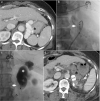A comprehensive review of transvenous obliteration techniques in the management of gastric varices
- PMID: 36960571
- PMCID: PMC10679599
- DOI: 10.5152/dir.2022.21193
A comprehensive review of transvenous obliteration techniques in the management of gastric varices
Abstract
Bleeding gastric varices (GVs) is a life-threatening complication of portal hypertension, with higher morbidity and mortality rates compared with bleeding esophageal varices (EVs). The endovascular techniques for the management of GVs are mainly transjugular intrahepatic portosystemic shunt (TIPS) and transvenous obliteration of the GVs. Transvenous obliteration techniques can be an alternative or an adjunct to TIPS for treatment of GVs, depending on the clinical scenario, and are less invasive than TIPS. However, these procedures are associated with increased portal pressure and related complications, mainly worsening of the EVs. In this article, the different techniques of transvenous obliteration of GVs, their indications, contraindications, and outcomes are discussed.
Keywords: Cirrhosis; TIPS; gastric varices; transvenous obliteration; upper GI bleeding.
Conflict of interest statement
The authors declared no conflicts of interest.
Figures







Similar articles
-
Balloon-Occluded Retrograde Transvenous Obliteration versus Transjugular Intrahepatic Portosystemic Shunt for the Management of Gastric Variceal Bleeding.Gut Liver. 2018 Nov 15;12(6):704-713. doi: 10.5009/gnl17515. Gut Liver. 2018. PMID: 29938456 Free PMC article.
-
Balloon-Occluded Retrograde Transvenous Obliteration (BRTO) Versus Transjugular Intrahepatic Portosystemic Shunt (TIPS) for Treatment of Gastric Varices Because of Portal Hypertension: A Systematic Review and Meta-Analysis.J Clin Gastroenterol. 2020 Aug;54(7):655-660. doi: 10.1097/MCG.0000000000001275. J Clin Gastroenterol. 2020. PMID: 31688366
-
Balloon-occluded antegrade transvenous obliteration with or without balloon-occluded retrograde transvenous obliteration for the management of gastric varices: concept and technical applications.Tech Vasc Interv Radiol. 2012 Sep;15(3):203-25. doi: 10.1053/j.tvir.2012.07.004. Tech Vasc Interv Radiol. 2012. PMID: 23021832 Review.
-
Transjugular intrahepatic portosystemic stent-shunt in the management of gastric and ectopic varices.Eur J Gastroenterol Hepatol. 2006 Nov;18(11):1155-60. doi: 10.1097/01.meg.0000236875.52730.b8. Eur J Gastroenterol Hepatol. 2006. PMID: 17033434 Review.
-
Transjugular intrahepatic portosystemic shunts and portal hypertension-related complications.World J Gastroenterol. 2014 Dec 7;20(45):16996-7010. doi: 10.3748/wjg.v20.i45.16996. World J Gastroenterol. 2014. PMID: 25493012 Free PMC article. Review.
Cited by
-
Biopsy forceps are useful for measuring esophageal varices in vitro.World J Gastrointest Surg. 2024 Feb 27;16(2):539-545. doi: 10.4240/wjgs.v16.i2.539. World J Gastrointest Surg. 2024. PMID: 38463364 Free PMC article.
-
Is salvage Plug-Assisted Retrograde Transvenous Obliteration (PARTO) safe and effective for bleeding gastric varices ?- A preliminary single-center experience.Emerg Radiol. 2024 Jun;31(3):359-365. doi: 10.1007/s10140-024-02232-2. Epub 2024 Apr 25. Emerg Radiol. 2024. PMID: 38664278
-
Exploring current practices and perspectives on gastric varices management in the US.Proc (Bayl Univ Med Cent). 2025 Jan 2;38(2):135-136. doi: 10.1080/08998280.2024.2446019. eCollection 2025. Proc (Bayl Univ Med Cent). 2025. PMID: 39989991 Free PMC article. No abstract available.
-
Milestones to optimize of transjugular intrahepatic portosystemic shunt technique as a method for the treatment of portal hypertension complications.World J Hepatol. 2024 Jun 27;16(6):891-899. doi: 10.4254/wjh.v16.i6.891. World J Hepatol. 2024. PMID: 38948432 Free PMC article.
References
-
- de Franchis R, Primignani M. Natural history of portal hypertension in patients with cirrhosis. Clin Liver Dis. 2001;5(3):645–663. - PubMed
-
- Sarin SK, Lahoti D, Saxena SP, Murthy NS, Makwana UK. Prevalence, classification and natural history of gastric varices: a long-term follow-up study in 568 portal hypertension patients. Hepatology. 1992;16(6):1343–1349. - PubMed
-
- Garcia-Tsao G, Abraldes JG, Berzigotti A, Bosch J. Portal hypertensive bleeding in cirrhosis: risk stratification, diagnosis, and management: 2016 practice guidance by the American Association for the study of liver diseases. Hepatology. 2017;65(1):310–335. - PubMed
-
- Ferral H, Gamboa P, Postoak DW, et al. Survival after elective transjugular intrahepatic portosystemic shunt creation: prediction with model for end-stage liver disease score. Radiology. 2004;231(1):231–236. - PubMed
-
- Montgomery A, Ferral H, Vasan R, Postoak DW. MELD score as a predictor of early death in patients undergoing elective transjugular intrahepatic portosystemic shunt (TIPS) procedures. Cardiovasc Intervent Radiol. 2005;28(3):307–312. - PubMed
Publication types
MeSH terms
LinkOut - more resources
Full Text Sources

